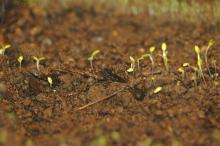Cause Damping-off can develop on the seed, radicle, hypocotyl, epicotyl, or stem of an emerged seedling. Damping-off is caused by the organisms Pythium spp., Rhizoctonia solani, and/or Fusarium spp. These organisms can also cause stem lesions and root rot of older delphinium plants.
Fusarium survives in the soil as thick-walled, dormant chlamydospores, which germinate in response to exudates from nearby plant roots. Hyphae then penetrate the roots, colonize the cortex, and move into the xylem tissue. Small spores (microconidia) are produced and carried up into the plant.
Rhizoctonia survives in the soil as sclerotia or as mycelium colonizing bits of organic matter. Roots become infected as they grow past these structures. The fungus then grows along the root surface, forms an aggregation called an infection cushion, and pushes into the root where it colonies, spreads, and kills the tissue. The fungus can form knots of mycelium that develop into sclerotia. These are released into the soil as the plant debris decomposes.
Symptoms Poor stand development or seedling collapse are indicative of damping-off. Seeds or emerging radicles may be rotted. After emergence, stem, root, and cotyledon may rot at or below the soil.
Pythium spp. causes a soft, mushy rot of ungerminated seeds. Once the radicle is extended or plant emerged, tissues can be attacked at any point. The infection starts as a brown, water-soaked spot that enlarges, becomes soft, and collapses.
Rhizoctonia solani will cause reddish brown to dark brown lesions that become slightly sunken. Stem and root lesions often are shallow but may extend deeper in young stem or root tissue. Sometimes, brown mycelia on the surface of the lesions may be visible with a hand lens.
Fusarium spp. causes darker red lesions that become brown with reddish borders to brown lesions with diffuse margins or similarly discolored longitudinal streaks. Stem and root lesions extend deep into the plant tissue.
Cultural control
- Plant seeds at the proper depth in well-drained soil of a high pH.
- Seed germination usually is higher if soils are moistened regularly but not saturated. It is important for the soil to dry down without drying out.
- Seeds should be planted when temperatures favor rapid germination and growth, so plants rapidly emerge and reach a more mature or hardened state.
- Avoid reusing pots or trays from a previous crop for propagation. If pots must be reused then wash off all debris and soak in a sanitizing solution or treat with aerated steam for 30 min.
Chemical control Chemical treatment should be preceded by an accurate diagnosis since most of the chemicals are not effective against all the pathogens that might cause damping-off.
For Rhizoctonia:
- Banrot 40 WP at 6 to 12 oz/100 gal water. Group 1 + 14 fungicide. 12-hr reentry.
- Cleary's 3336 EG at 8 to 16 oz/100 gal water as a drench. Inconsistent efficacy. Group 1 fungicide. 12-hr reentry.
- Medallion WDG at 2 oz/100 gal water if not phytotoxic. Use with oils or adjuvants may damage plant. Group 12 fungicide. 12-hr reentry.
For Pythium: Rotate fungicides from different groups that have a different mode of action for resistance management.
- Adorn at 1 to 4 fl oz/100 gal water plus another fungicide. Group 43 fungicide. 12-hr reentry.
- Banrot 40 WP at 6 to 12 oz /100 gal water. Group 1 + 14 fungicide. 12-hr reentry.
- Fosphite at 1 to 2 quarts/100 gal water. Do not use copper products within 20 days of treatment and do not use spray adjuvants. Group P7 fungicide. 4-hr reentry.
- Mefenoxam 2 AQ at 0.49 to 0.98 fl oz/100 gal water as a soil drench using 1 pint of solution per sq ft. Group 4 fungicide. No restrictions on reentry when used as a soil drench or media incorporation.
- MetaStar 2E at 0.5 to 2 fl oz/100 gal water. Group 4 fungicide. No restrictions on reentry when used as a soil drench or media incorporation.
- Monterey Garden Phos at 1 teaspoons/8 gal water as a soil drench. Group P7 fungicide. H
- Subdue MAXX at 0.5 to 1 fl oz/100 gal water and apply 1 pint/sq ft of solution. Group 4 fungicide. No restrictions on reentry when used as a soil drench.
- Terrazole 35 WP at 3.5 to 10 oz/100 gal water. Group 14 fungicide. 12-hr reentry.
For Fusarium:
- Cleary's 3336 EG at 8 to 16 oz/100 gal water as a drench. Group 1 fungicide. 12-hr reentry.
- Medallion WDG at 2 oz/100 gal water if not phytotoxic. Use with oils or adjuvants may damage plant. Group 12 fungicide. 12-hr reentry.
Reference Pirone, P. P. 1978. Diseases and Pests of Ornamental Plants, 5th ed. New York: John Wiley & Sons.


